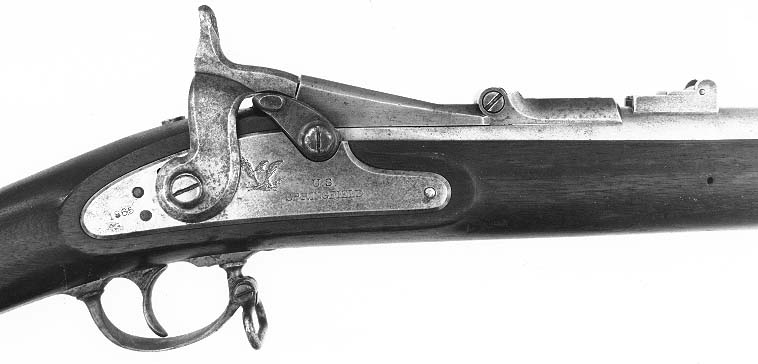 |
|---|
 |
|---|
| Overall Length | 55 15/16 Inches |
|---|---|
| Barrel Length (in bore) | 36.6 Inches |
| Cleaning Rod Length | 38 5/8 Inches,2 diameters, both threaded |
| Muzzle Diameter | .772 -.778 Inches |
| Rifling | 3 Lands and Grooves, 1 turn in 42" |
| Caliber | .50 CF, .50-70-450 Cartridge |
| Barrel Bands | 3, M63 bands, 11 1/16" apart |
| Cartouches | 1, Rect.if F-P War gun, 4 if US Service |
| Breech Block | 1866/Eagle |
| Firing Proof | None |
| Lock Plate | Dated 1862 -1865 |
| V/P/Eagle/p stamp | Possibly CW Eagle |
| Front sight | 1 1/4" from muzzle, 5/16" long |
| Fall 2013 |
|---|
| Model 1866 Rifle | NRA Very Good =$1,000 NRA Excellent = $2,500 |
|---|---|
| Model 1866 Short Rifle | NRA Very Good =$1,200
NRA Excellent = $2,500 |
| Model 1866 Cadet Rifle | NRA Very Good =$1,500 NRA Excellent = $3,500 |
The rifles were made by sleeving CW musket barrels to .50 caliber and cutting open the top of the breech for the hinged breech block. The barrel is finished in the bright, and the blackened breech block is dated "1866." The arm is equipped with a musket rear sight and a CW stock which was internally altered to accept the extractor and ejector mechanisms. The arm had a weak extractor mechanism and was not popular with troops. However, it is best known for its performance in the Hay Field and Wagon Box fights that occurred with Sioux and Cheyenne Indians in 1867.
There are not many Model 1866 Short rifles available. However, a number of Bannerman cut-down Model 1866 rifles are available with shortened stocks having fillers in the middle band spring location and usually thinned stock wrists. These arms should not be confused with the Springfield Model 1866 Short rifle. The Bannerman cut-down rifles should be considered parts guns. Their value is significantly less than that of a Springfield made M66 Short rifle.
The arms are difficult to locate and, when found, seem to have endured a considerable amount of stock and metal damage.